Clipart tagged: ‘bases’
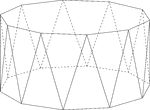
Decagonal Antiprism
Illustration of a decagonal antiprism. An antiprism is formed by having two parallel congruent bases…
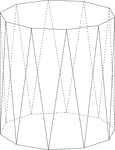
Decagonal Antiprism
Illustration of a decagonal antiprism. An antiprism is formed by having two parallel congruent bases…

Dodecagonal Antiprism
Illustration of a dodecagonal antiprism. An antiprism is formed by having two parallel congruent bases…
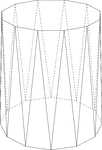
Dodecagonal Antiprism
Illustration of a dodecagonal antiprism. An antiprism is formed by having two parallel congruent bases…

Heptagonal/Septagonal Antiprism
Illustration of a heptagonal, or sometimes known as a septagonal antiprism. An antiprism is formed by…
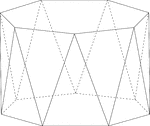
Heptagonal/Septagonal Antiprism
Illustration of a heptagonal, or sometimes known as a septagonal antiprism. An antiprism is formed by…
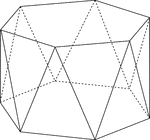
Hexagonal Antiprism
Illustration of a hexagonal antiprism. An antiprism is formed by having two parallel congruent bases…
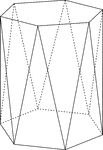
Hexagonal Antiprism
Illustration of a hexagonal antiprism. An antiprism is formed by having two parallel congruent bases…
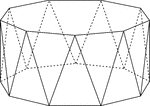
Nonagonal Antiprism
Illustration of a nonagonal antiprism. An antiprism is formed by having two parallel congruent bases…
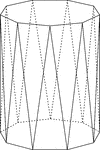
Nonagonal Antiprism
Illustration of a nonagonal antiprism. An antiprism is formed by having two parallel congruent bases…

Octagonal Antiprism
Illustration of an octagonal antiprism. An antiprism is formed by having two parallel congruent bases…
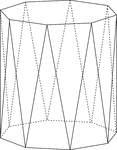
Octagonal Antiprism
Illustration of an octagonal antiprism. An antiprism is formed by having two parallel congruent bases…
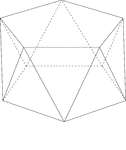
Pentagonal Antiprism
Illustration of a pentagonal antiprism. An antiprism is formed by having two parallel congruent bases…

Pentagonal Antiprism
Illustration of a pentagonal antiprism. An antiprism is formed by having two parallel congruent bases…
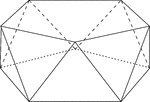
Pentagonal Antiprism
Illustration of a pentagonal antiprism. An antiprism is formed by having two parallel congruent bases…
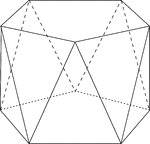
Pentagonal Antiprism
Illustration of a pentagonal antiprism. An antiprism is formed by having two parallel congruent bases…
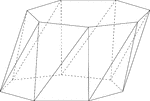
Skewed Heptagonal/Septagonal Antiprism
Illustration of a skewed (non-right) heptagonal, or sometimes known as a septagonal antiprism. An antiprism…
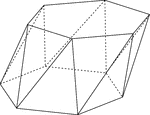
Skewed Hexagonal Antiprism
Illustration of a skewed (non-right) hexagonal antiprism. An antiprism is formed by having two parallel…

Skewed Nonagonal Antiprism
Illustration of a skewed (non-right) nonagonal antiprism. An antiprism is formed by having two parallel…

Skewed Octagonal Antiprism
Illustration of a skewed (non-right) octagonal antiprism. An antiprism is formed by having two parallel…
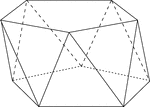
Skewed Pentagonal Antiprism
Illustration of a skewed (non-right) pentagonal antiprism. An antiprism is formed by having two parallel…
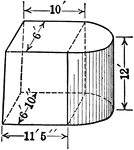
Composite Figure of Quadrilateral Frustum With Half of a Cylinder Attached
An illustration of a composite figure made up of a quadrilateral frustum and half of a cylinder. Frustum…
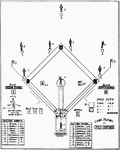
Baseball Game Illustration
This is an illustration of a baseball game. Baseball is played on a large field that has four bases…

Pentagon With Triangular Sections For Area
Pentagon with dimensions labeled. Pentagon can be used to calculate area by calculating individual triangles…
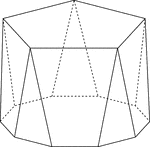
Polyhedron With Pentagon Bases
Illustration of a pentagonal polyhedron that is formed by having two parallel congruent pentagonal bases…

Polyhedron With Pentagon Bases
Illustration of a pentagonal polyhedron that is formed by having two parallel congruent pentagonal bases…

Polyhedron With Pentagon Bases
Illustration of a pentagonal polyhedron that is formed by having two parallel congruent pentagonal bases…
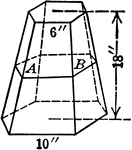
Pyramid Frustum With Hexagonal Bases and 6 inch and 10 inch Sides
An illustration of a pyramid with the top cut off by a plane parallel to the base. The remaining part…
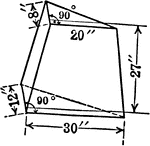
Pyramid Frustum With Triangular Bases and Height of 27 inches
An illustration of a pyramid with the top cut off by a plane parallel to the base. The remaining part…

Pyramid Frustum With Triangular Bases and Height of 27 inches
An illustration of a pyramid with the top cut off by a plane parallel to the base. The remaining part…
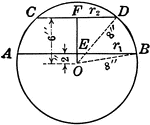
Sphere With 8-inch Diameter Cut by Planes
An 8-inch sphere cut by parallel planes, one 2 inches from center and the other 6 inches from center.…
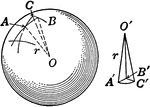
Sphere Cut Into Pyramids.
An illustration of a sphere cut into polygons as bases with their vertices at the center of sphere.

Zones or Segments of Spheres
An illustration of a zone of a sphere. A zone occurs when a sphere is cut by parallel planes that are…

Modern Enrichment Torus Moulding
The modern enrichment torus moulding is a bundle of round rods with ribbons twisted around. These designs…

Modern Enrichment Torus Moulding
The modern enrichment torus moulding is a bundle of round rods with ribbons twisted around. These designs…

Area of a Trapezoid
Illustration of a trapezoid with altitude a and bases b and b' used to demonstrate that the area is…
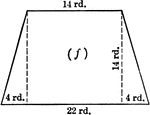
Trapezoid With Dimensions
Trapezoid with dimensions labeled. Trapezoid can be used to calculate area.

Trapezoid With Median
Illustration of a trapezoid, with the median drawn. The median of a trapezoid is parallel to the bases,…
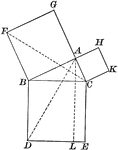
Right Triangle
Illustration of a right triangle used to show the Pythagorean Theorem (the square of the hypotenuse…
!["[A wedge] is simply a movable inclined plane, or two such planes united a their bases." -Avery 1895](https://etc.usf.edu/clipart/35900/35954/wedge2_35954_mth.gif)
Wedge Splitting Wood
"[A wedge] is simply a movable inclined plane, or two such planes united a their bases." -Avery 1895